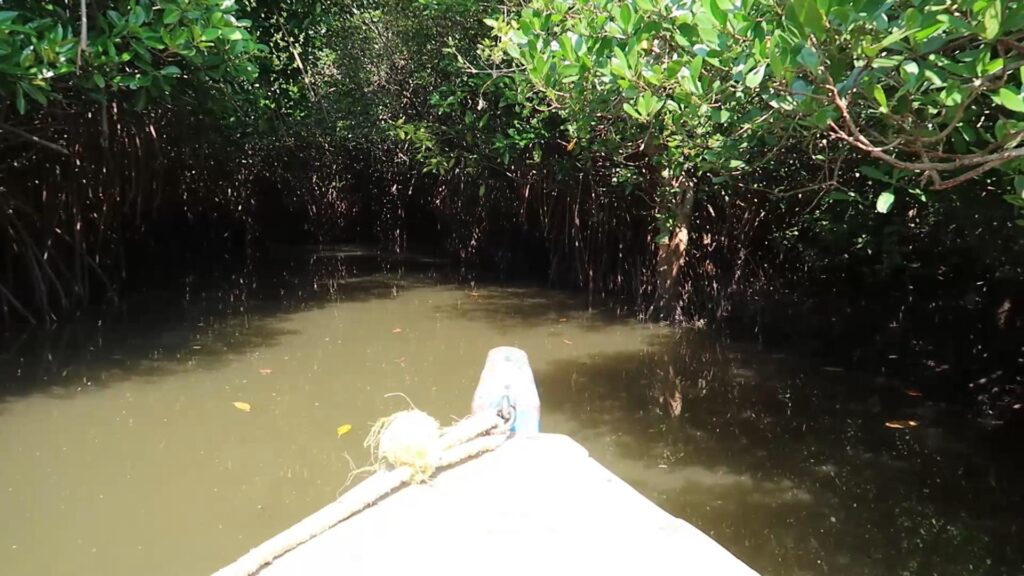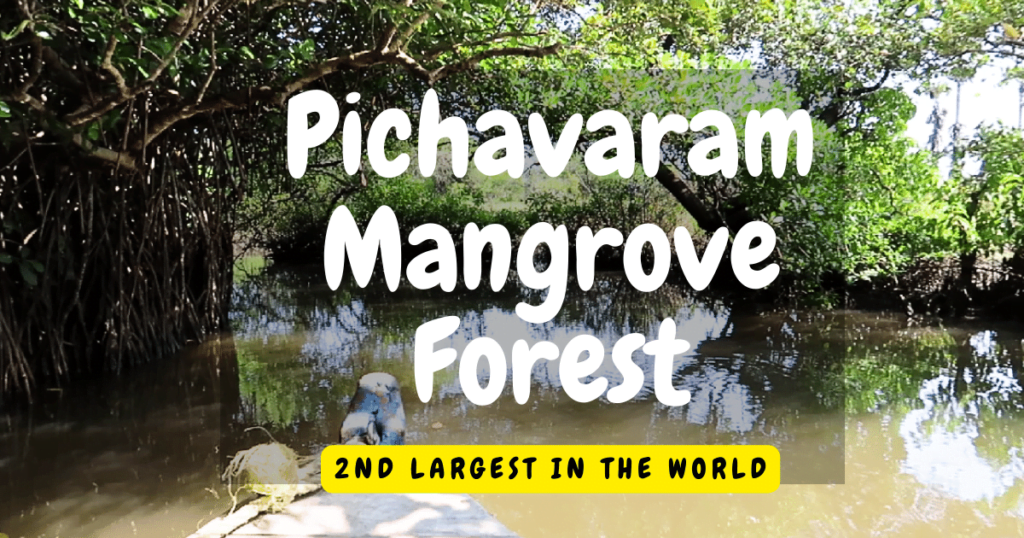


The Wonders of Pichavaram Mangrove Forest
The Pichavaram Mangrove forest located in the southwest part of Pondicherry is a spectacular example of natural beauty and is aptly nicknamed the ‘backwaters of the gods‘.
Pichavaram’s mangrove forest is a rare ecosystem habitat known as the ‘green lungs of Pondicherry’.
It is not just a mangrove forest, but also a popular tourist destination near Pondicherry
Pichavaram forest covers 2,300 hectares of land and is home to several small and big shallow coastal waterways, mud flats, and sand bars.
Because of this distinguishing feature, it is World’s Second Largest Mangrove Forest after the Sunderbans.
It is situated between the Bay of Bengal and the Vasishta Godavari River.
This mangrove forest’s enchanting terrain is ideal for nature enthusiasts who want to enjoy its calm and serene scenery.
Backwaters of the gods
Location and accessibility of Pichavaram Mangrove Forest
The Pichavaram Mangrove Forest is located about 230 km from Chennai and can be easily reached by road. The nearest airport is in Chennai, and there are regular bus services from major cities in Tamil Nadu. Once you arrive, you can explore the forest on foot or take a boat ride through the waterways to experience the beauty of the forest up close.
From Pondicherry you can take a bike/car rental or can commute by busses. It is approximately 77 Km and will take around 2 hours
Pichavaram Mangrove Forest Boating Price and Timings
Boats run from around morning 8 a.m. to evening 5 p.m. daily.
It does become really hot in the middle of the day, so go early in the morning or late in the afternoon.
Official boating activities are conducted by the Tamil Nadu Tourism Development Corporation and the Tamil Nadu Forest Department, however, local non-government boatmen are also accessible.
Various packages are available, with prices varying according to boat type, number of people, distance covered, and sights seen.
| Boat Type | Duration | Price (Per Boat) |
| Row Boat 4 – Seater | 60 Mins | 400 INR |
| Row Boat 6 – Seater | 60 Mins | 600 INR |
| Motor Boat 8 – Seater | 40 Mins | 1800 INR |
Natural Environment
Pichavaram Mangrove Forest is located at the confluence of the Vellar and Coleroon rivers and is a part of the Vellar-Coleroon estuarine system. This unique environment supports a diverse range of flora and fauna, including over 177 species of birds, 214 species of fish, 34 species of crustaceans, and 20 species of amphibians and reptiles.
Mangrove Forest Ecosystem
The Pichavaram Mangrove Forest is an important mangrove forest ecosystem that serves as a breeding ground for several species of fish, crustaceans, and other marine life. The forest is home to several species of mangroves, including Avicennia and Rhizophora, and provides habitat and food for several species of birds and other animals.
The forest is also an important source of livelihood for the local community, who depends on the forest for fishing and other activities. This delicate ecosystem is an important ecological hotspot that needs to be protected and preserved for future generations.
Importance of Mangrove Forests
Mangrove forests are one of the most important ecosystems on earth and play a vital role in mitigating the effects of climate change. They act as carbon sinks, absorbing and storing large amounts of carbon dioxide from the atmosphere, and also serve as a natural barrier against floods and storms.
Mangrove forests are also important breeding grounds for several species of fish and other marine life and provide habitat and food for several species of birds and other animals. Preserving mangrove forests is essential for maintaining the delicate balance of our planet’s ecosystems and mitigating the effects of climate change.
Also, do check the best places to visit in Pondicherry and most visited beaches in Pondicherry.


Things To Do at The Pichavaram Mangrove Forest
Boating: One of the most popular activities in Pichavaram Mangrove Forest is boating. You can hire a boat and explore the intricate waterways, taking in the stunning views of the mangrove forest. The boat ride can be a peaceful and serene experience that allows you to connect with nature.
Kayaking: For the more adventurous, kayaking is a great way to explore the narrow channels and tributaries of the mangrove forest. You can rent a kayak and navigate through the calm waters, experiencing the unique environment up close.
Fishing: Pichavaram Mangrove Forest is an angler’s paradise, with a wide variety of fish species to catch. You can bring your own equipment or hire a local guide to show you the best spots to fish.
Trekking: The forest offers several trekking trails that allow visitors to explore the diverse ecosystem of the mangrove forest. The trails are suitable for all levels of fitness and provide an opportunity to witness the beauty of the forest up close.
Bird Watching: Pichavaram Mangrove Forest is home to over 200 species of birds, making it a birdwatcher’s paradise. Visitors can spot a variety of migratory and resident birds, including egrets, herons, spoonbills, and kingfishers.
Photography: The unique and stunning beauty of the Pichavaram Mangrove Forest makes it an ideal destination for photography enthusiasts. You can capture the vibrant colors of the flora, the intricate network of waterways, and the diverse wildlife that call the forest home.
The Flora and Fauna of Pichavaram Mangrove Forest
The Pichavaram Mangrove Forest is home to a diverse range of flora and fauna, making it a unique ecosystem worth exploring. Here are some of the species you can expect to see while visiting the forest:
Mangrove Trees: The mangrove forest is dominated by the Avicennia and Rhizophora species of mangrove trees. These trees have adapted to the saline and brackish water of the forest, and their aerial roots provide a habitat for many aquatic organisms.
Other Flora: Apart from mangroves, Pichavaram Mangrove Forest is also home to other plant species such as wildflowers, ferns, and grasses.
Fish and Aquatic Life: The mangrove forest is teeming with life, including a variety of fish such as mullet, snapper, and catfish. You can also spot crabs, prawns, and other crustaceans in the shallow waters.
Reptiles and Amphibians: The forest is home to several reptile and amphibian species such as snakes, lizards, and frogs. The saltwater crocodile is also found in the forest, but sightings are rare.
Mammals: Though not as diverse as other species, the forest is home to several mammal species such as otters, civet cats, and wild boars.
Pichavaram Mangrove Forest: A Birdwatcher’s Paradise


The unique ecosystem of Pichavaram Mangrove Forest provides an ideal habitat for a wide range of bird species. From water birds to forest birds, Pichavaram Mangrove Forest offers a diverse range of birdwatching opportunities for bird lovers. The forest is home to more than 177 species of birds, making it a must-visit destination for birdwatchers.
Best Time for Birdwatching
The best time to visit Pichavaram Mangrove Forest for birdwatching is from November to February when the migratory birds flock to the forest. During this time, the forest is filled with a variety of birds from different parts of the world, making it an exciting time for birdwatchers.
Bird Species to Look Out For
Pichavaram Mangrove Forest is home to a diverse range of bird species, making it an ideal destination for birdwatching. The forest is home to both resident and migratory birds, and some of the most popular bird species to look out for include:
| Spot-billed Pelican Asian Openbill Black-crowned Night Heron Purple Heron Little Egret Indian Cormorant Grey Heron | Large Egret Paddy Bird Little Cormorant Painted Stork Spotted Dove Black Kite White-bellied Sea Eagle |
Tips for Birdwatching
Birdwatching in Pichavaram Mangrove Forest requires some patience and preparation.
Here are some tips to help you make the most of your birdwatching experience:
- Wear comfortable clothes and shoes.
- Carry binoculars and a camera to capture the birds in their natural habitat.
- Be patient and move slowly and quietly to avoid scaring away the birds.
- Hire a local guide to help you spot the birds and learn more about the forest.
- Avoid making loud noises or disturbing the birds.
Wrapping Up



Visitors can enjoy a range of activities such as boating, kayaking, fishing, trekking, and birdwatching, and experience the tranquility and beauty of the forest. With its important ecological significance, preserving the Pichavaram Mangrove Forest is essential for the health and well-being of our planet.
So, pack your bags and head to Pichavaram Mangrove Forest for an unforgettable experience. Don’t forget to bring your camera and capture the stunning vistas of the forest. Let’s work together to protect and preserve this vital ecosystem for generations to come.

